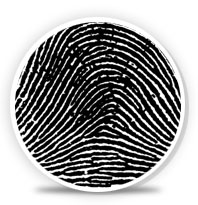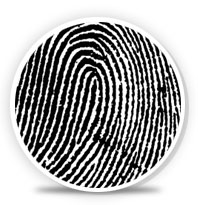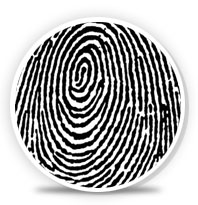
 The Arch: In arches, the finger ridges run constantly from one side of the finger to the other with no re-curving. There are two groups that further define the arch pattern.
The Arch: In arches, the finger ridges run constantly from one side of the finger to the other with no re-curving. There are two groups that further define the arch pattern.
Plain Arch - This pattern has a uniformity of flow to it. Starts from one side of a finger, and then ridge move upward a bit, almost resembling a wave out in the ocean. The plain arch then continues the journey along the finger to the other side. The plain arch is most simple of the fingerprint patterns to tell the difference.
Tented Arch - This pattern is same like the plain arch and it begins on one side of the finger and flows out in a related pattern to the other side. Though, the disparity in the tented arch is in the ridges in the center that are not constant as in the case of the plain arch. The ridges, which connect each other in the center, join and push upward, giving the idea of a pitched tent.
 The Loop: In loops, the ridges turn backwards but do not curl. This backward turn or loop is distinguished by how the loop flows in the hand and how it does not flow on the card on which the impression is taken. The mark on the fingerprint card is same as of the reverse image that we see when we see ourselves in the mirror.
The Loop: In loops, the ridges turn backwards but do not curl. This backward turn or loop is distinguished by how the loop flows in the hand and how it does not flow on the card on which the impression is taken. The mark on the fingerprint card is same as of the reverse image that we see when we see ourselves in the mirror.
 Radial Loop - These loops flow to the radius bone of the hand
Radial Loop - These loops flow to the radius bone of the hand
Ulnar Loop - These that flow when the descending slope of the loop is from the direction of the thumb toward the little finger of the hand.
Whorls: Whorls have patterns in which there are two or more deltas and there also exist a re-curve foregoing each delta. The four sub-groups of whorls are:
Spiral / Plain Whorl - In Whorls, build a turn of one complete route and therefore, are round or curved in shape. The plain whorl is the simplest of whorl and the most ordinary. There are at least two deltas and a ridge whose route can be curved, oval or round in shape.
Peacock's Eye / Central Pocket Whorl - In these whorls, one or more than one of the uncomplicated re-curves of the plain whorl re-curves twice. Composite / Double Loop Whorl – In these, there are two individual loop formations. In each of these, there are two completely divided and different sets of shoulders and deltas. Accidental Whorl - The work of the pattern is derived from two different types of patterns with at least two deltas. Whorls containing ridges match the characteristics of a meticulous whorl sub-grouping that are known as accidental whorls.
Variant / Accidental - The accidental pattern will contain two points of delta. One delta will be related to a re-curve and the other will be related to an upthrust.